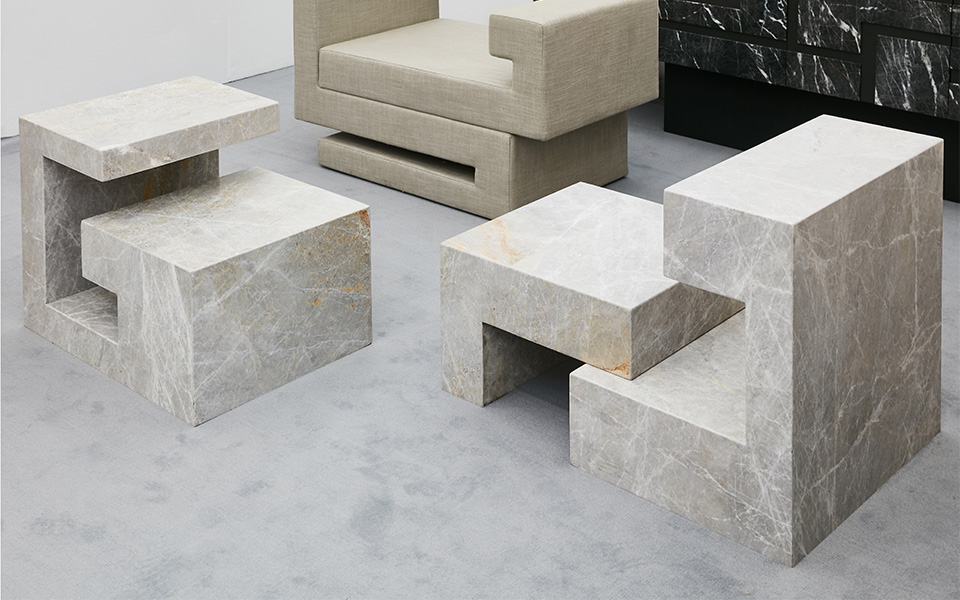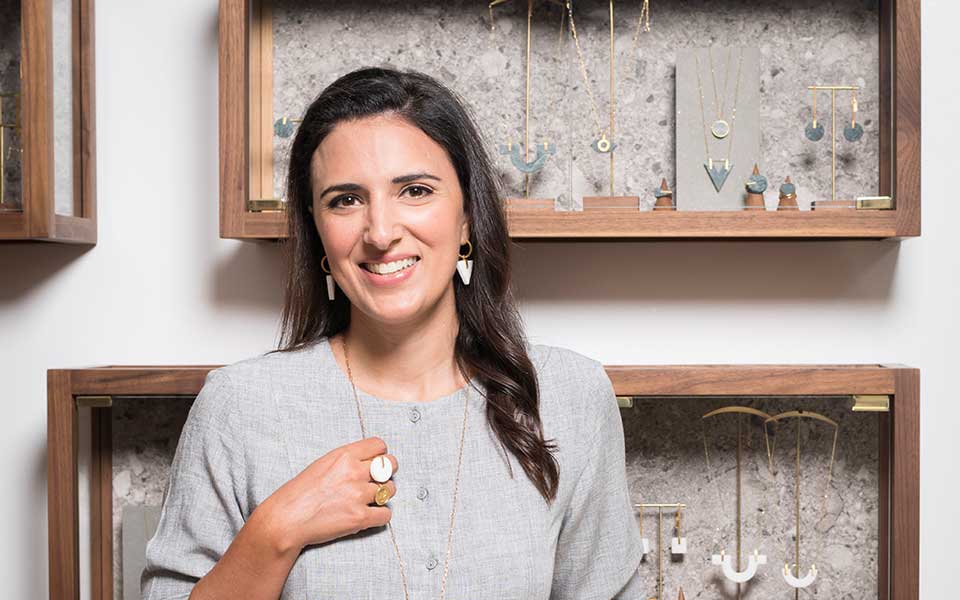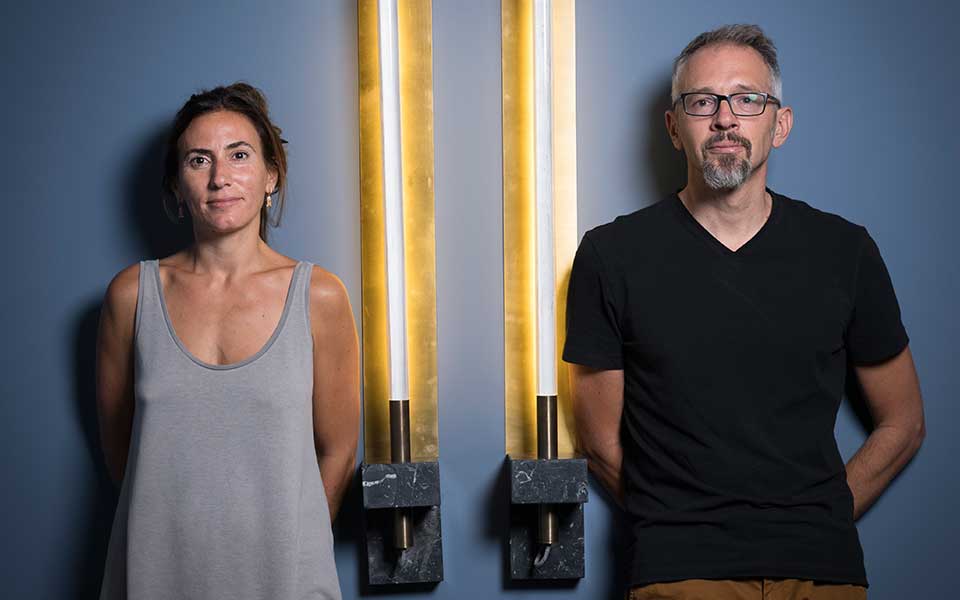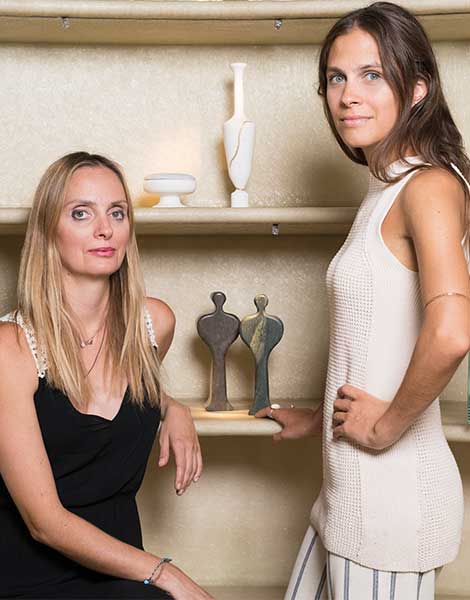Greek Designers: Crafting Beauty Inspired by Tradition and…
Explore these unique items by Greek…

Marble seats by Anaktae
Marble, the material most closely associated with classical elegance, is increasingly finding its way into contemporary designs. Doorknobs, lamps, jewelry, console tables and trays are just a few of the design items in which talented creatives are incorporating marble in bold, new ways.
Below are seven Greek designers who are taking this timeless material to new heights.

Dianna Karvounis and Vivian Philippa, the designers behind Anaktae
© Vangelis Zavos
Architectural symbols
From their memories they dredge up images of wonderful marble decorations that once adorned the facades of old Athenian apartment blocks. Their eyes light up as they recall marble fountains they have spotted at junkyards and vintage marblework in abandoned villas.
Cofounders of Anaktae, Vivian Philippa and Dianna Karvounis are passionate champions of the skill of Greece’s marble masons.
Both already with lengthy careers in their respective fields – Vivian in architecture and Dianna in industrial design, they began working together in 2009, each complementing the creative world of the other. They share the view that in Greece there are presumptions regarding the material and its cost, but consider flipping that image rather straightforward. “It has entered the world of fashion dynamically in recent years,” Dianna says, adding that some trends evolve over the years.
The pair themselves combine marble with rare woods or brass in a number of items: trays, candelabras and lights – both table and wall lamps, coffee tables, console tables and seats. All of their creations exhibit their refined design aesthetic, which uses archetypal symbols and forms in a contemporary way.
What excites them the most is the comprehensive study of a space, from its architectural design down the smallest details that affect its aesthetics. Currently they are conducting research into stone screens, decorative elements which are usually used in walls, offering natural light, aeration and privacy. “You can use marble anywhere you can think of, it has a limitless range of applications,” Vivian says.

Xenia Nefelly Vlachou
© Vangelis Zavos

Fashioning jewelry from white marble
© Marmarometry
Great cultural weight
In 2009, and having studied fashion design and fashion marketing, Xenia Nefelly Vlachou began taking jewelry-making lessons. “I had been designing jewelry since I was a student, but I never thought that I could do it professionally,” she says.
Initially she experimented with neoprene and wood, before later turning to marble. “The first reaction of suppliers and masons was disheartening – many didn’t even take a couple of minutes to hear me out,” she recalls. She finally found someone who would cut marble for use in small objects. She presented her first collection in January of 2015, and in the same year picked up awards at a competition held by the Fund of Archaeological Proceeds (TAP) for new designers in which she submitted three pieces.
“I wanted to work with a material that is ‘Greek’, with a massive cultural weight, and to bring it into today in a way that few could imagine,” she says.
Her creations, minimal and elegant, with architectural elements and geometric forms, are aimed at a broad audience and are intended for everyday, or formal looks.
“I’m captivated with rising to the challenge of something I have never tried before. Last year a girl brought me a piece of marble from Tinos and asked for a piece of jewelry that would remind her of her first holiday with her boyfriend. At the level of production there isn’t the time to sculpt, and nor do I have that knowledge. Whatever I have achieved, I have achieved working with my tools on pieces that I cannot use elsewhere. But to work the material alone brings you closer to artistic creation,” she says.

Alexander Papadias and Anna-Christina Fractopoulou
© Vangelis Zavos

makeWorkshop
Touching Marble
“In a way, I married into marble,” says the architect and designer Alexander Papadias. His wife and business partner – also an architect – comes from a family of marble masons from Ioannina.
“That was something that made accessing and experimenting with the material easier,” he says. He explains that, given the right circumstances, an architect always wants to have a say in the design of objects such as lighting fixtures or pieces of furniture.
In the depths of the economic crisis, the couple took on many jobs related to interior design and so, bit by bit, ended up designing items as a side job.
“What enchants us with marble, apart from its robustness, is the feeling you have when you touch it and feel its temperature. That’s why we try to include it in items with which the user will have more frequent bodily contact, such as doorbells, knobs, lamps… It may seem like a cold material, but that depends upon how you will use it. If you burn it, or hit it, you will have a more earthy result, which is removed from the stereotypical image that we Greeks have about the applications of marble.”
They both state that their design work has had a positive impact on the way that they now approach architecture: “You have contact with the material, and at a construction site you’re better placed to propose solutions, you achieve the desired result more painlessly. You have greater freedom and flexibility, you understand the difficulties the construction teams face. It is, additionally, very creative to design, and it counterbalances all of the rules that you need to follow working as an architect.”

Niki and Zoe Moskofoglou
© Vangelia Zavos

on entropy
The meaning of transformation
“Marble is defined best through its contradictions,” argue designers Niki and Zoe Moskofoglou. “Translucent and dense, strong and fragile, classic and modern.” The former is an architect, the latter a civil engineer with a postgraduate degree in cultural heritage. From 2010 they have focused on a material that they came to know through their metallurgist-engineer father.
It all began when Niki designed a lamp for her personal use. Orders from friends followed, and that prompted her to create the company Onentropy, a name inspired by a word with different interpretations in different fields – from thermodynamics to psychology. The two sisters focus on the transformation of the material.
“The sense of transformation is inherent in the material itself, that’s why we thought it was a fitting name,” they say. They recall how, when they showed their work a decade ago, viewers could hardly recognize what their lighting designs were made of. For the past five years, using marble has become an international trend and there are many types available to the designers, which allows them to work with flexibility using different textures.
From the first years of their partnership, to their participation in 2016 at the London Design Biennale and their most recent collections, their guiding principle remains the same.
“We design on the basis of a space, we think about how a piece of furniture can work in a specific context, what emotions it triggers in the user. We are not interested in something that works in isolation.”
Explore these unique items by Greek…
Pondering what to buy for yourself…
Don’t wait too long. One of…
A spiritual symbol that turned into…